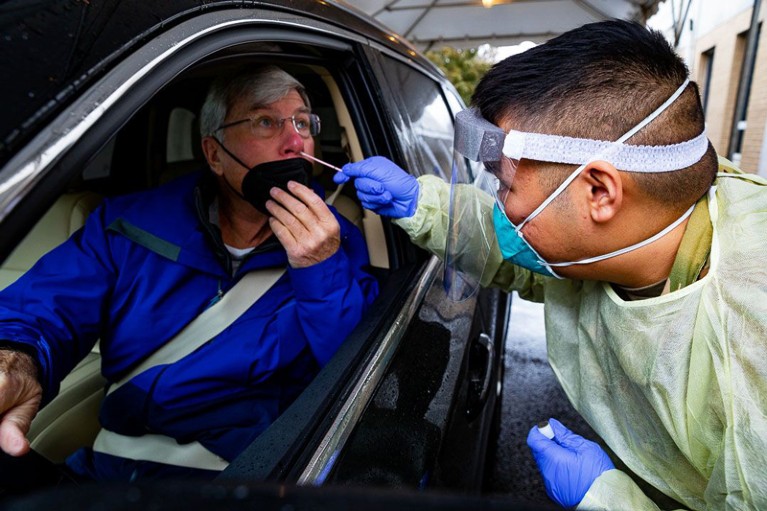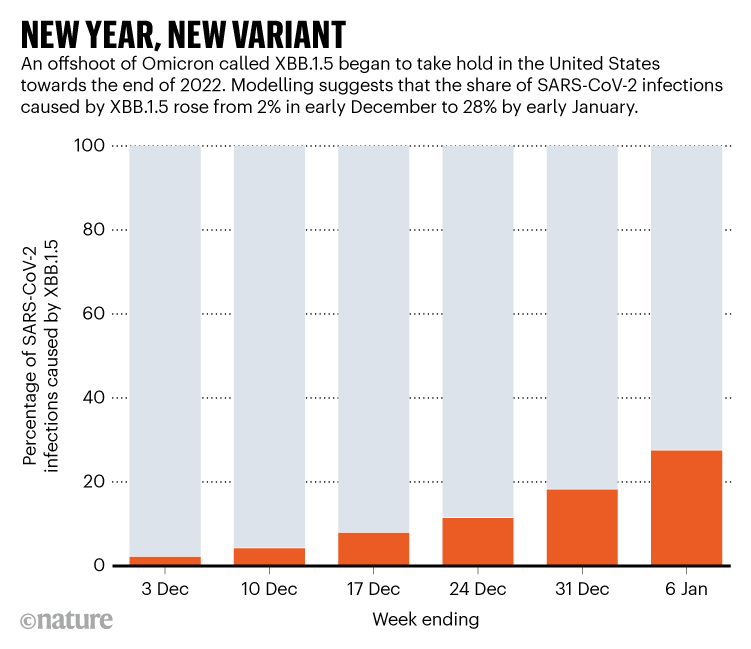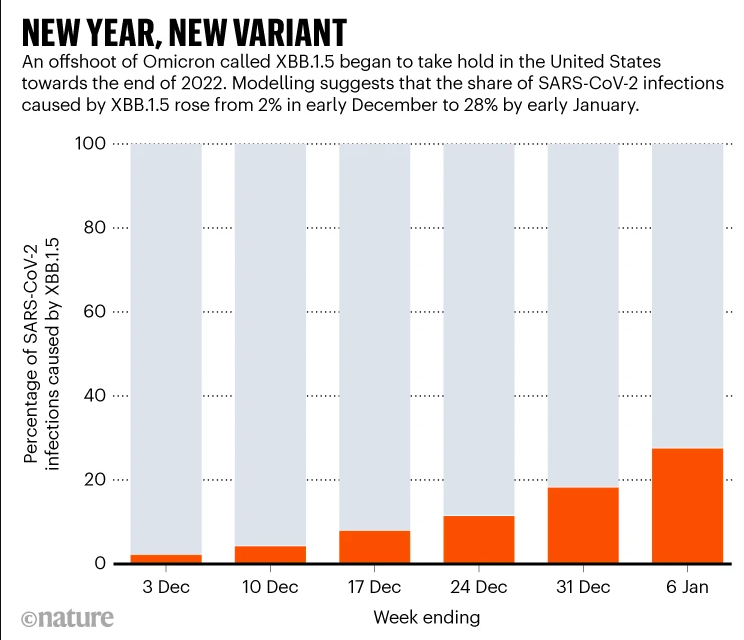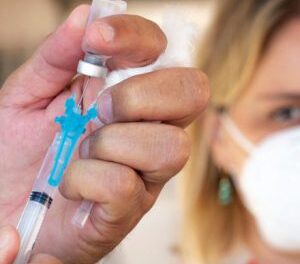
A driver is tested for COVID-19.Credit: US Army/ZUMA Press Wire Service/Shutterstock
New year, new variant. Just as scientists were getting to grips with the alphabet soup of SARS-CoV-2 variants circulating globally — your BQ.1.1, CH.1.1 and BF.7 — one lineage seems to be rising to the top, thanks to a peculiar new mutation.
The XBB.1.5 subvariant now makes up around 28% of US COVID-19 cases, according to projections from the US Centers for Disease Control and Prevention (CDC) in Atlanta, Georgia, and its prevalence is on the rise globally. In the Northeastern United States, it seems to have rapidly out-competed the menagerie of other immunity-dodging variants that were expected to circulate alongside one another this winter.
“It’s almost certainly going to dominate in the world. I cannot find a single competitor now. Everything else is incomparable,” says Yunlong Cao, an immunologist at Peking University in Beijing whose team is studying the properties of XBB.1.5 in the laboratory.
Scientists caution that XBB.1.5’s impact, in the United States and beyond, is still far from clear. The variant might not cause a big surge in infections or hospitalizations in many countries, thanks to high immunity built up from exposure to earlier waves of COVID-19 and vaccinations, particularly recent boosters for individuals most at risk of severe disease.
However, even if XBB.1.5 does not cause big COVID-19 waves, it will be important to track the lineage closely, researchers say. The subvariant bears a rarely seen mutation that might enhance its infectivity — and create an opportunity for further evolutionary gains.
Great-grandchild of Omicron
As its name suggests, XBB.1.5 is an offshoot of a SARS-CoV-2 variant called XBB. That lineage is a recombinant of two descendants of the BA.2 lineage that began spiking in early 2022; BA.2 itself is an offshoot of Omicron. XBB’s spike protein has a suite of mutations that boost the variant’s ability to evade antibodies. This has helped XBB to become common over the past few months, particularly in Asia, where it caused a surge in cases in Singapore.
Variant-watchers noticed XBB.1.5 in late 2022, thanks to a rarely seen amino-acid change, called F486P, in the spike protein. Experiments from Cao’s lab suggest that the mutation improves the variant’s ability to attach to the human ACE2 receptor, which SARS-CoV-2 uses to invade cells1. Importantly, the mutation doesn’t seem to erode XBB’s prowess at eluding antibodies. The results were posted to the bioRxiv preprint server on 5 January and have not yet been peer reviewed. “XBB really sucks at ACE2 binding,” says Cao, and the F486P change present in XBB.1.5 helps to surmount that shortcoming.
The relationship between a variant’s ability to attach to ACE2 and its transmissibility isn’t fully clear, says Jesse Bloom, an evolutionary virologist at the Fred Hutchinson Cancer Center in Seattle, Washington. But for XBB.1.5, “F486P seems to have given it another boost, which is enabling the virus to spread”, he says.

Source: US Centers for Disease Control and Prevention
The CDC estimates that XBB.1.5 is the second most common variant in the United States, comprising 28% of cases nationally, and upwards of 70% in the northeast (see ‘New year, new variant‘). Moritz Gerstung, a computational biologist at the German Cancer Research Centre in Heidelberg, estimates that cases of the variant are doubling roughly every week in the United States, and a bit more slowly in other countries where the variant has appeared. That’s comparable to the rate at which the BQ.1 and BQ.1.1 variants grew in September 2022, but slower than earlier Omicron waves. “XBB.1.5’s spread is still impressively fast,” Gerstung says.
What’s not clear is whether such growth will be sustained or whether the variant will drive up infections significantly, Gerstung adds. BQ.1 and BQ.1.1 looked set to drive sizeable waves, only to run out of steam in Europe and North America. If the same thing happens with XBB.1.5, the lineage could wind up silently replacing other variants in some countries without causing a big rise in cases.
Big-city variant
Jennifer Surtees, a biochemist at the University at Buffalo in New York, wonders whether researchers are overestimating XBB.1.5’s growth in the Northeastern United States. The variant has become more common in the western New York sequences her team handles, but she hasn’t yet noticed the meteoric rise in XBB.1.5 genomes that labs in New York City are recording.
Gauging XBB.1.5’s impact might not be straightforward, owing to the drop-off in testing for COVID-19, Surtees adds. “I think that we are truly flying blind right now. We have no idea how many cases are really out there.”
Tulio de Oliveira, a bioinformatician at Stellenbosch University in South Africa, thinks researchers should look at hospital cases and other measures of disease severity to best measure XBB.1.5’s impact. Factors such as a cold snap in the Northeastern United States and holiday gatherings could partly explain the variant’s apparent surge, he says. “I think that many scientists are jumping to conclusions and predictions very early and with very little data.”
Evasion expert
One thing that researchers can agree on is that XBB.1.5, like its predecessor XBB, is a master of immune evasion. It carries numerous spike mutations that blunt the potency of antibodies raised by vaccination and infection — including earlier Omicron strains. Bivalent vaccines boost levels of antibodies capable of blocking XBB infection (and probably XBB.1.5) in lab tests2,3, but not by much, notes Cao.
Throughout 2022, researchers including Cao watched Omicron lineages pick up a succession of antibody-evading mutations in the viral spike protein that allowed new lineages to overcome immunity gained from vaccines and previous waves. XBB.1.5 is vastly more transmissible than other circulating variants thanks to the addition of the F486P mutation, so there is currently little evolutionary pressure on the lineage to change further, says Cao.
But as global immunity to the subvariant builds, XBB.1.5 won’t stand still, he says. “We are going to see a lot of new mutations that we have never seen before.”
Nature 613, 222-223 (2023)
doi: https://doi.org/10.1038/d41586-023-00014-3












